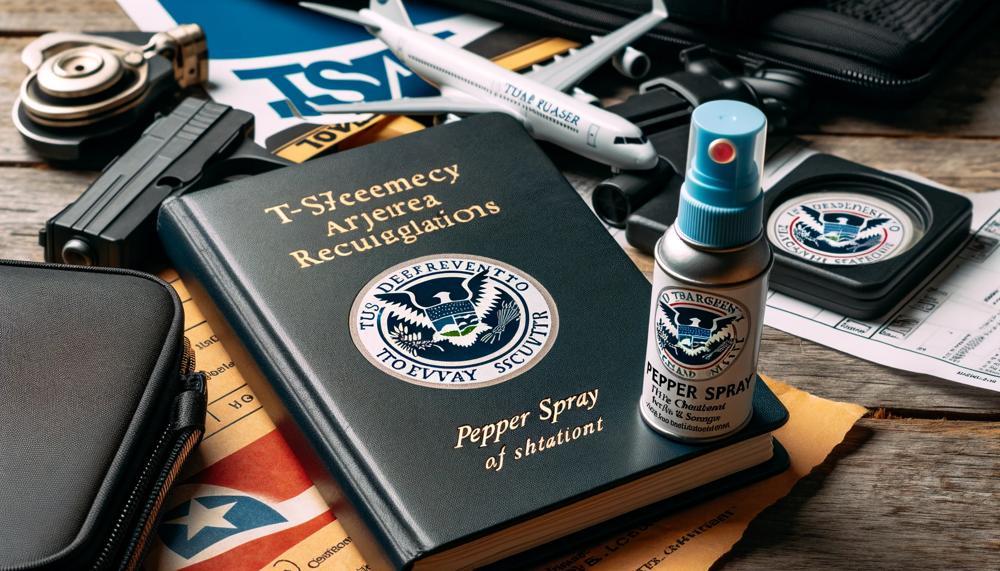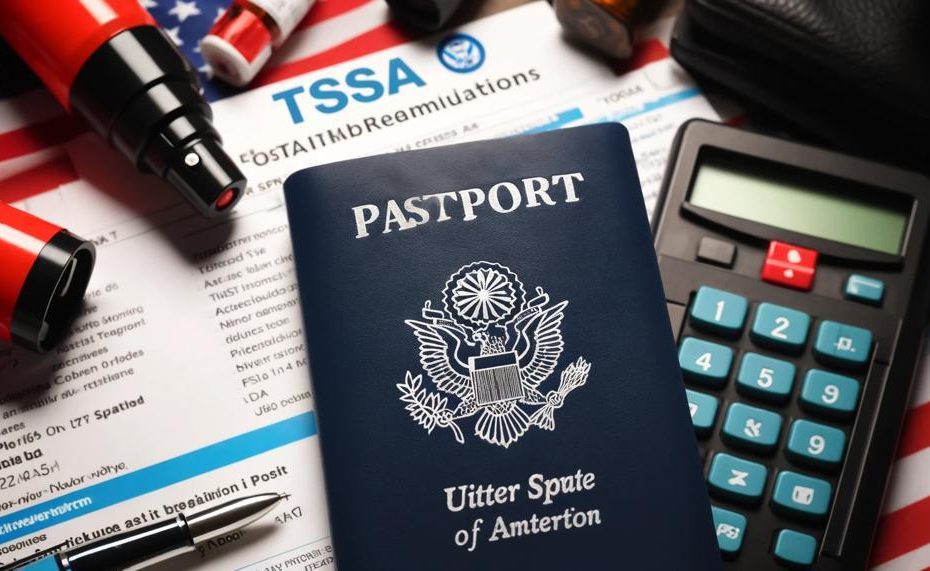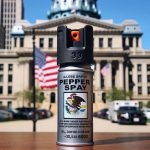There were a huge number of personal defense items, like pepper sprays, turned in at checkpoints last year, according to the Transportation Security Administration (TSA). This shocking fact sheds light on a problem that many travelers face: how to balance their own safety with strict security measures.
It can be hard for tourists to figure out how to pack personal safety items like pepper spray for flights because of the complicated web of laws, safety rules, and useful packing tips.
Before you leave on this trip, you need to know exactly what you can and cannot bring through airport security. Expertise in packing with TSA rules in mind is necessary for people who are determined to bring personal defense sprays on trips.
The purpose of this post is to simplify the process and make it easier for visitors from all over the world. We’ll talk about the pros and cons of taking pepper spray on vacation, give you practical tips on how to pack with peace of mind, and go over the most important steps to make sure you follow TSA rules.
So, can you take pepper spray through tsa?
According to the Transportation Security Administration (TSA), you are not allowed to carry pepper spray in your carry-on bags. However, you can pack one 4 fl. oz. (118 ml) container of mace or pepper spray in your checked baggage, provided it is equipped with a safety mechanism to prevent accidental discharge.
Please note that self-defense sprays containing more than 2 percent by mass of tear gas (CS or CN) are prohibited in checked baggage. It’s also recommended to check with your airline, as some may not allow this item in checked bags.
Let’s get started.
Contents
Can you bring pepper spray on a plane?
Bringing pepper spray onto a plane isn’t as straightforward as chucking it into your bag and forgetting about it. You’ve got to navigate a maze of rules that the Transportation Security Administration (TSA) and airlines throw at you.
| Requirement | Description | Note |
|---|---|---|
| Size Limit | 4 fl. oz. (118 ml) or smaller | Only one container per passenger |
| Checked Baggage | Pepper spray must be in checked luggage | Carry-on is a no-go |
| Safety Mechanism | Must have a safety cap or lock | Prevents accidental discharge |
| Tear Gas Content | Less than 2% CS or CN | Check the label for compliance |
| Legal Compliance | Ensure legality at destination | Rules can vary internationally |
To avoid a tangle with airport security, first ensure your pepper spray is petite—no more than 4 fl. oz. Next up, check that bad boy in; the cabin’s a no-pepper zone.
Your spray should have some sort of safety cap or lock to keep it from going rogue in the hold. The TSA is picky about chemicals, so make sure your spray is playing nice with a tear gas content under 2%.
Lastly, don’t forget to look up the legalities of your landing spot; you don’t want to start your adventure in the clink.
To sum it up, pepper spray can fly, but it’s got to comply.
TSA compliant pepper spray
TSA compliant pepper spray is a self-defense spray that adheres to specific guidelines set by the Transportation Security Administration for air travel. To ensure you can take your pepper spray through airport security without a hitch, here’s the lowdown:
Understanding TSA Compliant Pepper Spray
- Size Matters: The pepper spray container must not exceed 4 fluid ounces.
- Safety Mechanism: A safety mechanism to prevent accidental discharge is mandatory.
- Tear Gas Content: The spray can contain oleoresin capsicum but must have no more than 2% of tear gas compounds.
Safely Transporting Pepper Spray in Air Travel
| Requirement | Details | Why It’s Important |
| Checked Baggage Only | Pepper spray must be packed in checked luggage. | Ensures the safety of passengers and crew. |
| Limited Quantity | Only one 4 fl. oz. (118 ml) container is allowed. | To minimize risks in case of accidental discharge. |
| Safety Features | Must have a secure safety mechanism. | Prevents the spray from being triggered unintentionally. |
| Check Legality | Confirm it’s legal at your destination. | Laws on pepper spray vary globally; ensures compliance. |
Tips for Trouble-Free Travel with Pepper Spray
- Before You Pack: Always check the expiry date of your pepper spray. An expired canister may not work as expected when you really need it.
- Airline Policies Matter: Though TSA provides guidelines, airlines might have stricter rules. It pays to check with your carrier before heading to the airport.
- International Considerations: If you’re flying abroad, dive into the destination country’s regulations on carrying pepper spray. Rules can vary widely and ignorance won’t excuse you from legal repercussions.
Pepper spray is a potent tool for personal safety, but it comes with responsibility, especially when flying. By following these directives, you’re not just complying with the law; you’re ensuring the safety and peace of mind for yourself and fellow travelers.
TSA pepper spray rules
Pepper spray, a critical self-defense tool for many, navigates a tightrope of regulations when it comes to air travel.
The Transportation Security Administration (TSA) has set clear guidelines for passengers intending to pack pepper spray for their journeys.
| Item | Carry-On Baggage | Checked Baggage |
| Pepper Spray | Prohibited | Limited to one 4 fl. oz. (118 ml) container with a safety mechanism |
| Additional Requirements | N/A | Must be packed in a manner that prevents accidental discharge |
Vital Points to Remember:
- Carry-On No-No: Got pepper spray? It’s a no-go in your carry-on. The TSA won’t allow these sprays on your person or in your hand luggage due to safety concerns.
- Checked Baggage Yes-Yes: Fancy bringing pepper spray along for your trip? You can pack one container of pepper spray, not exceeding 4 fl. oz., in your checked luggage. This rule keeps you ready for self-defense upon reaching your destination.
- Safety First: Any pepper spray you pack must have a safety mechanism to prevent any accidental release. This is crucial for the safety of everyone involved in handling your baggage.
- When Mistakes Happen: Slipped a spray into your carry-on by accident? Don’t sweat it. Let a TSA officer know straight away. They’re there to help, not to hassle.
Packing It Right:
Choosing a reputable brand is key. Opt for pepper sprays designed specifically for travel, featuring robust safety locks to avoid any in-flight accidents.
Before You Fly:
Check the laws at your destination. Some places have strict rules or even bans on pepper sprays. A bit of homework before your trip can save you a heap of hassle later.
Why It Matters:
Safety’s the top dog in air travel, and pepper spray carries its weight in providing peace of mind. Following these TSA rules ensures you, your fellow travelers, and airline staff have a safe and pleasant journey.
Why is pepper spray restricted on planes?
Pepper spray is a no-go on airplanes, and here’s why: it’s all about safety and legal stuff. When you’re up in the air, in that tight space, if pepper spray goes off, it’s chaos. Everyone could get hurt, including passengers and crew.
It’s not just about the pain and panic, but also about how safe the flight is. Plus, if someone with bad intentions gets their hands on it, that’s a real danger. And let’s not forget, the law’s pretty strict about this.
If you try to bring pepper spray on a plane, you could get fined big time, or even worse, face jail time. So, it’s a big no-no to bring pepper spray on planes. Better to stick to other ways to feel safe, like personal alarms or not flying solo.
- Harm and Chaos: If pepper spray gets used in a plane, everyone’s going to feel it. It’s not just the person sprayed, but everyone around. That can cause a lot of panic and harm, which is a no-go when you’re flying.
- Misuse Risks: There’s always a chance someone could use pepper spray for the wrong reasons. That’s a risk the airlines don’t want to take.
- Legal Trouble: If you’re caught with pepper spray, you’re looking at fines from $250 to $1500. That’s not pocket change. And in some cases, you might even get banned from flying or face criminal charges.
Mace versus pepper spray
Pepper spray and mace are often spoken of like they’re twins – similar, but each with their own quirks and features.
To clear the air, let’s get into the nitty-gritty of these personal safety champs, focusing on what sets them apart and how they fare when facing the Transport Security Administration (TSA) at the airport.
Mace vs. Pepper Spray: The Lowdown
At their core, both are designed to give you an edge in dodgy situations, but it’s the composition and effects that set them apart. Mace, historically speaking, was a brand name that became synonymous with self-defense sprays, including traditional chemical mace (CN) and modern pepper sprays.
However, the original chemical mace is now less common, with many opting for pepper spray for its natural, oleoresin capsicum (OC) base – the same fiery compound that gives chilli peppers their kick.
| Aspect | Mace (Traditional Chemical) | Pepper Spray |
| Base Compound | CN (Phenacyl chloride) | OC (Oleoresin Capsicum) |
| Effects | Tears, pain, and temporary blindness | Intense burning sensation, inflammation of eyes and mucous membranes, coughing, and temporary blindness |
| Legality and Accessibility | Varies, generally less accessible due to its chemical nature | Widely accessible; legal restrictions vary by location |
| Training and Handling | Recommended | Strongly recommended |
Taking Your Defender through TSA
When it comes to travelling, the TSA has a clear stance on what flies and what doesn’t – quite literally. While the previous section highlighted the no-go for pepper sprays on planes, the truth isn’t as cut and dried. According to TSA guidelines, both mace and pepper spray are allowed in checked baggage with restrictions: the safety mechanism must prevent accidental discharge, and the container must not exceed 4 fluid ounces.
However, remember, the final call rests with the TSA officer at the checkpoint. Their main gig is keeping passengers safe, so if there’s any doubt about your spray, it might have to sit out the flight.
Choosing Your Can of Courage
Deciding between mace and pepper spray boils down to preference and how comfortable you feel handling each. While pepper spray takes the lead in popularity due to its natural base and effectiveness, don’t discount personal comfort and familiarity with the product.
Before making a decision, consider:
- The legalities in your area
- Ease of access and use
- Your own sensitivity to chemicals
- Training availability
Pepper spray often emerges as the go-to for personal safety. Its immediate, fiery retribution against threats makes it a solid ally. However, whichever you choose, ensure you’re clued up and ready to use it responsibly.
Is pepper spray legal in every state?

Pepper spray is a legal self-defense tool across the United States, but its legality can vary significantly by state due to differing regulations on its sale, possession, and use.
Below, I provide a breakdown of general legality and notable restrictions in key states to aid understanding for those considering pepper spray for self-protection.
General Legality of Pepper Spray
Pepper spray is broadly legal in all 50 states for self-defense purposes, aimed at enabling individuals to protect themselves from threats.
However, there are specific nuances in some states that might include restrictions on the age of the person carrying it, the amount they can carry, or the strength of the formulation.
| State | Legal Status | Notable Restrictions |
| New York | Legal | Sold in pharmacies and by licensed firearms dealers; must be a resident. |
| California | Legal | Canisters must be less than 2.5 ounces. |
| Michigan | Legal with restrictions | OC concentration must be less than 10%; size limits apply. |
| Wisconsin | Legal with restrictions | Must not contain more than 10% OC; weight restrictions apply. |
Considerations for Travel
Regarding travel, especially air travel governed by the Transportation Security Administration (TSA), pepper spray has specific handling requirements:
- Checked Bags Only: Pepper spray is allowed in checked baggage with severe restrictions — the container must not exceed 4 fluid ounces and must be equipped with a safety mechanism to prevent accidental discharge.
- Declaration Required: It is mandatory to declare these items to the airline during the check-in process, ensuring they are aware and can verify that the item is packed appropriately.
- Prohibited in Carry-Ons: Carrying pepper spray in your carry-on bags or on your person is strictly prohibited and can lead to confiscation, fines, or even criminal charges.
Considering the variable state laws and TSA requirements, it is crucial for travelers who wish to carry pepper spray to familiarize themselves with both state regulations and TSA guidelines to ensure compliance and avoid legal complications.
Airline policies on pepper spray
The current TSA regulations stipulate quite clear guidelines when it comes to packing pepper spray for a flight. It’s a bit of a tightrope, balancing safety and security.
Understanding TSA Regulations on Pepper Spray
Pepper spray, a popular self-defence tool, is permitted on flights with certain restrictions. Specifically, it must be packed in checked luggage, not carry-on.
There are also limits on the size and type of pepper spray canisters allowed. Here’s a more detailed look:
| Location | Size Restrictions | Safety Mechanisms |
| Checked Baggage | Not exceeding 4 fl. oz. (118 ml) | Must include a safety mechanism to prevent accidental discharge |
| Carry-On Baggage | Not allowed | N/A |
| Additional Notes | FAA requires an additional cap or safety feature for the trigger | |
While TSA provides a federal guideline, airlines might tighten the leash further. Always double-check with your airline since what flies with one might not with another. A quick call or a browse through their website could save you a headache at the airport.
In essence, while you can take pepper spray on a flight, the devil’s in the details. Make sure it’s tucked away in your checked baggage, meets size and safety criteria, and won’t cause a fuss at your destination.
Bear spray
Bear spray and traditional pepper spray serve different purposes and exhibit distinct characteristics, particularly in their capsaicinoid concentrations, intended targets, and effective range. Understanding these differences is crucial for choosing the right spray for your safety needs.
Moreover, when it comes to travelling, especially through airports, knowing the Transportation Security Administration (TSA) regulations on carrying such items is essential.
Key Differences Between Bear Spray and Traditional Pepper Spray
| Aspect | Bear Spray | Pepper Spray |
| Primary Use | Deterring aggressive or charging bears | Self-defence against human attackers |
| Capsaicinoid Concentration | Lower concentration (approx. 1-2%) | Higher concentration (up to 10%) |
| Range | Up to 30 feet | 6-12 feet |
| Legality and Restrictions | Legal in most states for use against animals | Regulated by self-defence laws; legality varies by state and country |
TSA Regulations on Bear Spray
Regarding TSA regulations, bear spray is categorized under prohibited items for carry-on bags, owing to its potential as a hazardous material.
However, you may transport bear spray in checked baggage with certain restrictions:
- The canister must not exceed 4 ounces (118 ml).
- It should be equipped with a safety mechanism to prevent accidental discharge.
- The traveller is responsible for declaring these items to the airline and ensuring compliance with both TSA and the specific airline’s policies.
Rules for international travel
When it comes to navigating the rules for international travel, particularly the Transportation Security Administration (TSA) regulations concerning the carriage of pepper spray, the details are precise and critical for travellers aiming to carry such items for self-defense. Below is a straightforward guide on these rules:
| Item | Carry-on Baggage | Checked Baggage |
|---|---|---|
| Pepper Spray/Mace | Not Permitted | Permitted with Restrictions* |
| Bear Spray | Not Permitted | Restricted (Often not allowed) |
| Pepper Spray Lighters | Not Permitted | Not Permitted |
| Keychain Pepper Spray | Not Permitted | Permitted with Restrictions* |
*Restrictions for Checked Baggage:
- The pepper spray container must not exceed 4 fl. oz. (118 ml).
- It should have a safety mechanism to prevent accidental discharge.
- The content must not exceed 2% tear gas (CS or CN).
- Always check with the specific airline as policies can differ.
- Pepper spray must be declared when entering a new country, respecting the destination’s legal framework.
Notably, while TSA provides a unified guideline, the legality and acceptance of pepper spray vary across international borders, making it imperative to verify the destination country’s laws. Additionally, bear spray, designed for deterring wildlife and not suitable for personal defense against humans, follows a different set of considerations and is generally not permitted on flights.
Travelers should also be aware that pepper spray, like any other security device, comes with an expiration date—typically ranging from 2 to 5 years. An expired canister not only loses its efficacy but also violates transportation rules if found in luggage.
Navigating through airport security with items intended for self-defense necessitates a blend of caution, awareness, and preparation.
Conclusion
To get through the complicated world of flying with pepper spray, it’s important to understand the delicate balance between personal safety and following the rules. To make sure that people who are traveling follow strict safety rules when they bring personal defense items like pepper spray, the Transportation Security Administration (TSA) has created a specific framework. To be exact, pepper spray containers can’t be bigger than 4 ounces; they must have a safety feature to keep them from accidentally releasing pepper spray; and they can only be present in checked bags.
This article has gone through the complicated world of safety and legal issues and given visitors clear, useful advice. From why you need to make sure that carrying pepper spray is allowed where you’re going to practical packing and reporting tips, the goal has been to give you the information you need to make an informed choice about bringing personal defense sprays on your trip.
The most important thing to remember is how important it is to be ready and follow the TSA’s rules. While traveling, making sure your pepper spray is TSA-approved is a big step toward keeping yourself safe without breaking the rules that protect everyone’s health.





